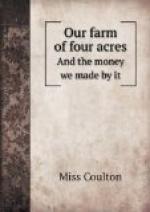We always found that the deeper the sets were placed in the ground the sounder were the roots: We tried every experiment with them; and as our gardener was both skilful and industrious, we were usually much more fortunate with our produce than our neighbors.
Carrots rank to the “small farmer” next in value to the potatoes; not only pigs and cows are fond of them, but likewise horses. The pony always improved in condition when he was allowed to have a few daily.
Our arable acre was a model farm on a very small scale. We grow in it maize for the poultry, tares for the pigeons, lucerne for the cows, and talked of oats for the pony. This our gardener objected to, so the surplus bit of ground was sown with parsnips, which turned out very profitable, as both pigs and cows liked them.
We have told the reader that we reared the calf of the Strawberry cow, and it cost us hardly anything to do so, for it was fed in the winter with the roots we had to spare. The first winter it had to consume the greater part of the ton of mangel-wurzel we had bought “to keep our cows together.” Some we had boiled with potatoes for the pigs, and they liked it very well.
An acre of land may appear a laughably small piece of ground to produce such a variety of articles, but if well attended to the yield will astonish those who are ignorant of gardening. The one important thing to be attended to is, to see that all seed-crops are well thinned out as soon as they are an inch above the surface. In very few kitchen-gardens is this attended to, and for want of this care a dozen carrots, parsnips, or turnips, are allowed to stand where one would be sufficient. The one would prove a fine root; the dozen are not worth the trouble of pulling, as they can get neither air nor room to grow. To be well done they should be thinned by hand, and that being a tedious “job,” gardeners seldom can be induced to perform the work properly.
As our ground became productive we added another cow, and more pigs and poultry, but I shall not now say with what success. This little book in only intended for the novice in farming, and details only the results of the first six months of our “farm of four acres.”
Perhaps I should have called it five acres, as nearly the whole of the acre of kitchen-garden was devoted to the cultivation of food for our “stock.”
We had a very broad sunny border at the back of the flower-garden, which grew nearly all the spring and summer vegetables we required: such as seakale, early potatoes, peas cauliflowers, and salads.
We have not yet said anything of the money we saved by our kitchen-garden, but we must add to the profits of our six months’ farming the average amount we should have paid to a green-grocer for fruit and vegetables.
Twenty-five cents a day to supply thirteen persons with these necessary articles is certainly not more than must have been expended. Still, $90 per annum is a considerable item of household expenditure, and scanty would have been the supply it would have furnished; as it was we had a profusion of fruit of all kinds, from the humble gooseberry and currant to the finest peaches, nectarines, and hothouse grapes, as well as an abundant supply of walnuts and filberts.




